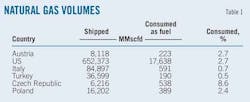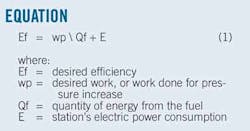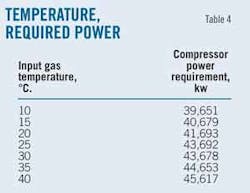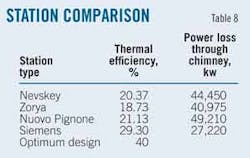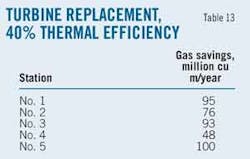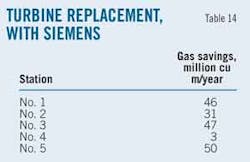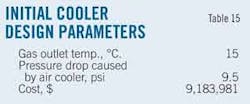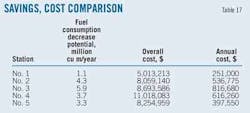COMPRESSOR OPTIMIZATION—1: Energy recovery guides natural gas pipeline system efficiency
Shaghayegh Khalaji
National Iranian Gas Co.
Tehran
Economic analyses demonstrate the operational benefits of using particular energy recovery and scrubber technologies on natural gas transmission systems. The first article of this series, presented here, details these analyses as applied to Iran's gas system. The concluding article will focus on the effect of scrubbers and other equipment in attempting to maximize capital return.
Background
Iran is one of the largest consumers of natural gas in the world. Several transmission pipelines move natural gas across the country, with compressor stations roughly 100 km apart. Existing information regarding gas consumption by compressor stations in Europe cannot be directly applied to Iranian stations due differences in line length and the need to first define a number of consumption indices.
Table 1 shows the energy consumed transmitting gas in some countries.
Comparison, however, requires development of suitable indices. This article compares the power required for gas transfer via pipeline by first calculating the power needed by each station per 1 million cu m gas/km/day.
Table 2 shows this power index for a variety of countries.
Table 3 shows the calculated power requirement for gas transfer of 1 million cu m gas/km/day on three Iranian pipeline networks. Iranian power requirement are about 60% more than the other countries.
Investigation parameters
The classic definition of efficiency of thermodynamic systems centers on increasing energy per unit of consumed fuel. Increases in either pressure or temperature can increase the power produced by compressor stations. Pressure is a desired increase in this context, temperature is not.
Equation 1 defines desired efficiency, an index for comparing different stations.
Calculating required power involves extracting enthalpy of output gas pressure and input gas temperature from thermodynamic tables and determining gas flow rate. Thermal efficiency and energy wasted in different sections of the compressor are part of this calculation.
Operational conditions
Simulating a station using HYSYS software and existing data allowed study of changing operating conditions on compressor station performance , including the pressure drop in scrubber and air coolers (Fig. 1).
The following conditions governed the simulation:
• Flow rate passing through the station, 80 MMscfd.
• Input gas pressure, 700 psi.
• Output gas pressure, 1,000 psi.
Table 4 shows input gas temperature's effect on compressor station power under constant pressure conditions for each period. Decreasing input gas temperature allows pressurization with smaller amounts of power. Each 1° C. decrease in input gas temperature causes roughly a 0.5% decrease in required power.
A scrubber causes pressure drop of 5-6.5 psi when clean and 18.5-24.5 psi when dirty. Compressor station simulation calculations show a 5 psi pressure drop reduces power requirements by 850 kw. Each 1 psi drop decreases compressor power requirements by 0.39%.
Compensating for the pressure drop caused by air coolers requires increasing compressor station pressure. Holding both input gas pressure to the compressor and the output gas pressure from the station constant, each 1 psi pressure drop caused by air coolers increases power requirement by about 0.27%.
Sensitivity analysis
Sensitivity analysis used a gas thermal value of 36,000 kilojoule/cu m and gas turbine efficiency of 32% (based on the average of installed compressors) to investigate solutions for decreasing compressor power requirements. Cooling input gas by 1° C. yielded roughly 55,000 cu m/year gas savings.
Researches also investigated pressure drop in the scrubber stemming from nonobservance of design principles and, in some cases, failure to replace the scrubber filter in a timely manner. Table 5 shows scrubber pressure drop's effects on turbine performance.
This article only investigates pressure drops up to 25 psi, but field observations show drops as large as 30-50 psi in scrubbers.
Study included investigating reduced pressure drop in air coolers, holding input gas pressure to the compressor and output pressure from the station constant. Calculations show each 1 psi pressure drop in air coolers saving 315,000 cu m/year of natural gas.
Energy loss
Determining energy balance is the best way to compare design conditions and optimum operational conditions and to calculate energy loss.
After investigating global energy consumption norms in gas transfer projects and determining the essential indices and parameters affecting operational conditions, researchers sought to determine energy loss points and determine energy savings potentials.
Investigating efficiency of selected compressor stations along the three pipelines showed it to be lower than designed. Some stations with 10-25 Mw gas turbines installed were producing <4 Mw, prompting a 3-year study to determine energy loss by each station component. Investigating turbine efficiency showed that only Siemens turbines closely approximated to design operations.Other turbines had lower performance in most cases (Fig. 2).
Turbines lose most of their power through the exhaust system. Investigation showed Siemens turbines losing less than others through this path.
Compressors
Investigating compressors revealed the following characteristics:
• Compressor 260-13-1. Installed in old Russian stations, real power consumption was higher than designed power consumption by 400-1,000 kw, growing as rpm's increased.
• Compressor PCL 802-3. Operates with Nuovo Pignone turbo compressors. Power consumption was 400-1,000 kw higher than designed and efficiency 5-10% lower.
• Compressor BCL 605. Also uses Nuovo Pignone turbo compressors. Power consumption is 200-1,300 kw higher than designed and the difference between designed polytrophic efficiency and operational efficiency 5-9%.
• Simner-design compressors. Used 0.5-1.5 Mw more power than designed. Operational efficiency in Sinner-design E compressors was 5-7% lower than designed polytrophic efficiency in most instances.
Scrubbers
Scrubbers are responsible for nearly 10% of compressor stations' energy loss. More than 40% of scrubbers were dirty (resulting in a 10-25 psi pressure drop) and nearly 10% were completely out of commission (resulting in >25 psi pressure drop). Pressure drop under optimum conditions is 5-10 psi.
Air coolers
Aspen-HTFS+ software-based simulation compared air cooler function with design parameters.
Researchers used designed gas flow conditions to compare air cooler efficiency with international standards. The actual pressure drop of 9.6 psi exceeded expectations of 8.5 psi.
Tested air coolers had a hairpin arrangement, with total output gas of the turbocompressor flowing into a common header and then being divided between air coolers by an input header before entering transformer tubes. Other air coolers have a straight arrangement, with total output gas of each turbocompressor directly entering an air cooler bank.
Pressure drops more rapidly in a straight configuration. Researchers found a 14.3 psi pressure drop in straight-designed air coolers. Using hairpin air coolers reduces pressure drop, decreasing gas consumption. Table 6 shows the effects of a reduced pressure loss in hairpin air coolers.Optimizing air cooler design in a straight arrangement reduces pressure loss even further (Table 7).
Savings potential
Identifying energy loss points allowed definition of potential savings and recovery. Energy savings possibilities included reducing:
• Energy loss from scrubber pressure drop.
• Energy loss from air cooler pressure drop.
• Electrical energy consumption in air coolers.
Potential energy recovery lay in reducing energy leaving compressor stations through the chimney. Energy captured by reducing pressure drop can be applied to transmission instead.
Table 8 shows the two parameters used in calculating energy savings and thermal recovery values.
Energy lost through a station's chimney reduces gas turbine thermal efficiency. Studying the polytrophic efficiency and consumption power of compressors also showed potential to save large volumes of fuel gas (Table 9).
Table 10 shows scrubber performance.
Energy consumption
This article initially outlined existing energy consumption norms in gas pipelines and describED essential parameters and criteria for comparing operational conditions with design conditions and optimum conditions. It then discussed the potential energy savings found in each compressor station component. It will now turn to available means for realizing these savings and an economic analysis of the results.
Gas turbines
Methods for energy savings and recovery in compressor stations' gas turbines include:
• Using a recuperator.
Air entering a combustion chamber is preheated by hot air leaving the turbine and entering a recuperator. This system, however, is suitable only for gas turbines with low power and low pressure ratios. High-pressure turbines suffer from low efficiency when using a recuperator since the pressure loss is greater. Recuperators could only operate at those Iranian compressor stations using Nevsky systems.
• Cooling the input air.
• Recovering energy lost through the chimney.
• Replacing the gas turbine.
Inlet air
Practical methods for cooling a compressor station's inlet air include:
• Direct evaporation system.
• Absorption, mechanical chillers.
• Underground channels.
Table 11 summarizes the effects of each on Siemens compressors.
Cooling the inlet air has a negligible effect on system efficiency, and is suggested only for stations facing operational limitations in hot months of the year.
In-chimney recovery
Either a Kalian cycle or organic Rankine cycle (ORC) chimney unit can recover energy from the chimney.
• Kalian cycle is useful when the exhaust-gas temperature from the chimney is low, limiting possible energy recycling. In Iran such conditions occur only when using Nevsky gas turbines. Since these turbines have very low efficiency, however, they are not good candidates for energy recycling equipment and should instead be replaced by higher-efficiency turbines.
Table 12 summarizes Kalian cycle's effect on Nevsky units under design conditions. The authors do not recommend their use. ORC cycle is the best energy recovery solution. Fluid selection is based on gas turbine conditions, local conditions, and the technology used by the manufacturer. But average ORC cycle efficiency at compressor station chimney temperature is about 10%. The low temperature in Nevsky gas turbine chimneys, however, precludes use of the ORC cycle on efficiency grounds.
Calculations show recoverable power in compressor stations using ORC cycles of about 120 kw/hr. Since the recovered energy in the ORC cycle is electrical and electric energy use in compression stations is low, the saved electric energy is best used to start another gas compressor by electric motor.
Turbine replacement
Gas turbines normally operate at lower efficiency than their design condition. Reconstructing compressor stations and replacing gas turbines can increase thermal efficiency. This article considers two turbine replacement scenarios. Table 13 shows energy savings stemming from replacing existing turbines with units having 40% better thermal efficiency. In the second scenario, Siemens turbines replace the existing units, resulting in the energy savings shown in Table 14.
Feed cooling
Cooling a compressor station's gas feed can decrease its power requirement. Either a chiller or an air cooler can cool the gas feed. Preliminary calculations show a chiller uses too much energy to be economical. Table 15 shows general specifications of an air cooler used in cooling a compressor station's gas feed.
Table 16 shows the reduced power needs and fuel requirement realized by using an air cooler for a year, given that the ambient temperature is cooler than the gas feed. Table 17 shows the cost savings potential achieved by using air coolers at five other stations in differing climates.
The author
More Oil & Gas Journal Current Issue Articles
More Oil & Gas Journal Archives Issue Articles
View Oil and Gas Articles on PennEnergy.com

